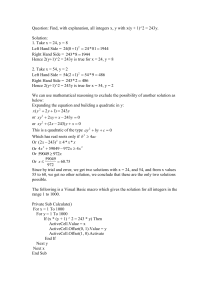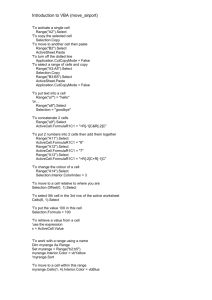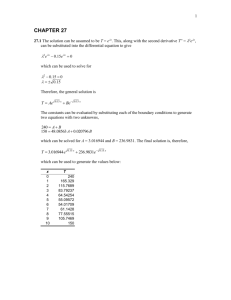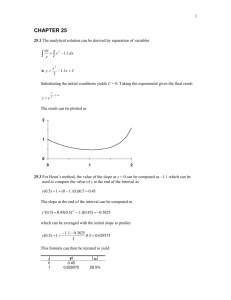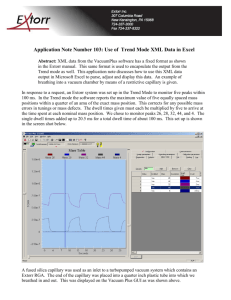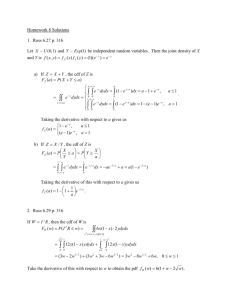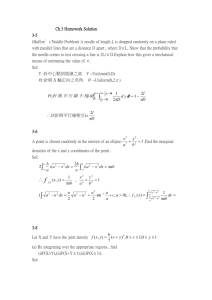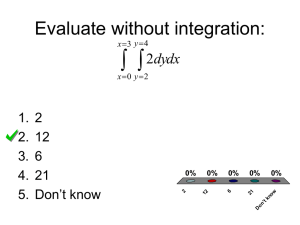Chapter 23 Odd Problem Solutions
advertisement
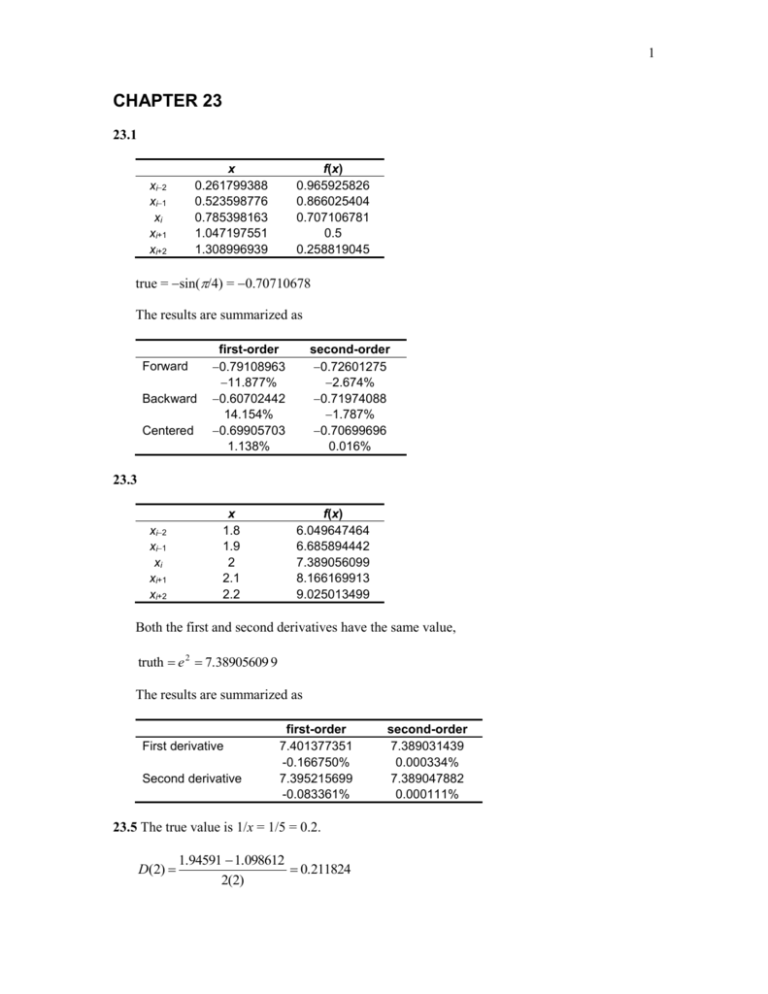
1
CHAPTER 23
23.1
f(x)
0.965925826
0.866025404
0.707106781
0.5
0.258819045
x
0.261799388
0.523598776
0.785398163
1.047197551
1.308996939
xi2
xi1
xi
xi+1
xi+2
true = sin(/4) = 0.70710678
The results are summarized as
Forward
Backward
Centered
first-order
0.79108963
11.877%
0.60702442
14.154%
0.69905703
1.138%
second-order
0.72601275
2.674%
0.71974088
1.787%
0.70699696
0.016%
23.3
xi2
xi1
xi
xi+1
xi+2
x
1.8
1.9
2
2.1
2.2
f(x)
6.049647464
6.685894442
7.389056099
8.166169913
9.025013499
Both the first and second derivatives have the same value,
truth e 2 7.38905609 9
The results are summarized as
First derivative
Second derivative
first-order
7.401377351
-0.166750%
7.395215699
-0.083361%
23.5 The true value is 1/x = 1/5 = 0.2.
D(2)
1.94591 1.098612
0.211824
2(2)
second-order
7.389031439
0.000334%
7.389047882
0.000111%
2
D(1)
1.791759 1.386294
0.202733
2(1)
4
1
D (0.202733) (0.211824) 0.199702
3
3
23.7 At x = xi, Eq. (23.9) is
f ' ( x) f ( xi 1 )
2 xi xi xi 1
2 xi xi 1 xi 1
f ( xi )
( xi 1 xi )( xi 1 xi 1 )
( xi xi 1 )( xi xi 1 )
f ( xi 1 )
2 xi xi 1 xi
( xi 1 xi 1 )( xi 1 xi )
For equispaced points that are h distance apart, this equation becomes
f ' ( x) f ( xi 1 )
2 x ( x i h) ( x i h)
h
h
f ( xi ) i
f ( xi 1 )
h(2h)
h( h)
2h( h)
f ( xi 1 )
f ( xi 1 ) f ( xi 1 ) f ( xi 1 )
0
2h
2h
2h
23.9 The first forward difference formula of O(h2) from Fig. 23.1 can be used to estimate the
velocity for the first point at t = 0,
f ' (0)
58 4(32) 3(0)
km
1.4
2(25)
s
The acceleration can be estimated with the second forward difference formula of O(h2) from
Fig. 23.1
f " (0)
78 4(58) 5(32) 2(0)
km
0.0096 2
2
(25)
s
For the interior points, centered difference formulas of O(h2) from Fig. 23.3 can be used to
estimate the velocities and accelerations. For example, at the second point at t = 25,
f ' (25)
58 0
km
1.16
2(25)
s
f " (25)
58 2(32) 0
km
0.0096 2
2
(25)
s
For the final point, backward difference formulas of O(h2) from Fig. 23.2 can be used to
estimate the velocities and accelerations. The results for all values are summarized in the
following table.
3
t
0
25
50
75
100
125
y
0
32
58
78
92
100
v
1.40
1.16
0.92
0.68
0.44
0.20
a
-0.0096
-0.0096
-0.0096
-0.0096
-0.0096
-0.0096
23.11 Here is a VBA program uses Eq. 23.9 to obtain first-derivative estimates for unequally
spaced data.
Option Explicit
Sub TestDerivUnequal()
Dim n As Integer, i As Integer
Dim x(100) As Double, y(100) As Double, dy(100) As Double
Range("a5").Select
n = ActiveCell.Row
Selection.End(xlDown).Select
n = ActiveCell.Row - n
Range("a5").Select
For i = 0 To n
x(i) = ActiveCell.Value
ActiveCell.Offset(0, 1).Select
y(i) = ActiveCell.Value
ActiveCell.Offset(1, -1).Select
Next i
For i = 0 To n
dy(i) = DerivUnequal(x, y, n, x(i))
Next i
Range("c5").Select
For i = 0 To n
ActiveCell.Value = dy(i)
ActiveCell.Offset(1, 0).Select
Next i
End Sub
Function DerivUnequal(x, y, n, xx)
Dim ii As Integer
If xx < x(0) Or xx > x(n) Then
DerivUnequal = "out of range"
Else
If xx < x(1) Then
DerivUnequal = DyDx(xx, x(0), x(1), x(2), y(0), y(1), y(2))
ElseIf xx > x(n - 1) Then
DerivUnequal = _
DyDx(xx, x(n - 2), x(n - 1), x(n), y(n - 2), y(n - 1), y(n))
Else
For ii = 1 To n - 2
If xx >= x(ii) And xx <= x(ii + 1) Then
If xx - x(ii - 1) < x(ii) - xx Then
'If the unknown is closer to the lower end of the range,
'x(ii) will be chosen as the middle point
DerivUnequal = _
DyDx(xx, x(ii - 1), x(ii), x(ii + 1), y(ii - 1), y(ii), y(ii + 1))
Else
'Otherwise, if the unknown is closer to the upper end,
'x(ii+1) will be chosen as the middle point
DerivUnequal = _
4
DyDx(xx, x(ii), x(ii + 1), x(ii + 2), y(ii), y(ii + 1), y(ii + 2))
End If
Exit For
End If
Next ii
End If
End If
End Function
Function DyDx(x, x0, x1, x2, y0, y1, y2)
DyDx = y0 * (2 * x - x1 - x2) / (x0 - x1) / (x0 - x2) _
+ y1 * (2 * x - x0 - x2) / (x1 - x0) / (x1 - x2) _
+ y2 * (2 * x - x0 - x1) / (x2 - x0) / (x2 - x1)
End Function
When the program is run, the result is shown below:
The results can be compared with the true derivatives which can be calculated with analytical
solution, f(x) =5e–2x – 10xe–2x. The results can be displayed graphically below where the
computed values are represented as points and the true values as the curve.
0.2
0
-0.2
0
1
2
3
4
5
-0.4
-0.6
-0.8
An even more elegant approach is to put cubic splines through the data (recall Sec. 20.2 and
the program used for the solution to Prob. 20.10) to evaluate the derivatives. Here is the result
of applying that program to this problem.
5
0.2
0
-0.2
0
1
2
3
4
5
-0.4
-0.6
-0.8
23.13 (a) Create the following M function:
function y=fn(x)
y=1/sqrt(2*pi)*exp(-(x.^2)/2);
Then implement the following MATLAB session:
>> x=-2:.1:2;
>> y=fn(x);
>> Q=quad(@fn,-1,1)
Q =
0.6827
>> Q=quad(@fn,-2,2)
Q =
0.9545
Thus, about 68.3% of the area under the curve falls between –1 and 1 and about 95.45%
falls between –2 and 2.
(b)
>>
>>
>>
>>
>>
>>
>>
x=-2:.1:2;
y=fn(x);
d=diff(y)./diff(x);
x=-1.95:.1:1.95;
d2=diff(d)./diff(x);
x=-1.9:.1:1.9;
plot(x,d2,'o')
6
Thus, inflection points (d2y/dx2 = 0) occur at –1 and 1.
23.15
Program Integrate
Use imsl
Implicit None
Integer::irule=1
Real::a=-1.,b=1,errabs=0.0,errrel=0.001
Real::errest,res,f
External f
Call QDAG(f,a,b,errabs,errrel,irule,res,errest)
Print '('' Computed = '',F8.4)',res
Print '('' Error estimate ='',1PE10.3)',errest
End Program
Function f(x)
Implicit None
Real:: x , f
Real::pi
Parameter(pi=3.1415927)
f=1/sqrt(2.*pi)*exp(-x**2/2.)
End Function
Answers:
x = -1 to 1: Computed =
x = -2 to 2: Computed =
x = -3 to 3: Computed =
0.6827 Error estimate = 4.069E-06
0.9545 Error estimate = 7.975E-06
0.9973 Error estimate = 5.944E-06
23.17 MATLAB Script saved as prob2317.m:
%Numerical Integration of sin(t)/t = function sint(t)
%Limits: a=0, b=2pi
%Using the "quad" and "quadl" function for numerical integration
%Plot of function
t=0.01:0.01:2*pi;
y=ff2(t);
plot(t,y); grid
7
%Integration
format long
a=0.01;
b=2*pi;
Iquad=quad('ff2',a,b)
Iquadl=quadl('ff2',a,b)
function y=ff2(t)
y=sin(t)./t;
MATLAB execution:
>> prob2317
Iquad =
1.40815163720125
Iquadl =
1.40815163168846
23.19
%
%
%
%
%
%
Finite Difference Approximation of slope
For f(x)=exp(-2*x)-x
f'(x)=-2*exp(-2*x)-1
Centered diff. df/dx=(f(i+1)-f(i-1))/2dx
+ O(dx^2)
Fwd. diff.
df/dx=(-f(i+2)+4f(i+1)-3f(i))/2dx + O(dx^2)
Bkwd. diff.
df/dx=(3f(i)-4f(i-1)+f(i-2))/2dx + O(dx^2)
x=2;
fx=exp(-2*x)-x;
dfdx2=-2*exp(-2*x)-1;
%approximation
dx=0.5:-0.01:.01;
for i=1:length(dx)
%x-values at i+-dx and +-2dx
xp(i)=x+dx(i);
x2p(i)=x+2*dx(i);
xn(i)=x-dx(i);
x2n(i)=x-2*dx(i);
8
%f(x)-values at i+-dx and +-2dx
fp(i)=exp(-2*xp(i))-xp(i);
f2p(i)=exp(-2*x2p(i))-x2p(i);
fn(i)=exp(-2*xn(i))-xn(i);
f2n(i)=exp(-2*x2n(i))-x2n(i);
%Finite Diff. Approximations
Cdfdx(i)=(fp(i)-fn(i))/(2*dx(i));
Fdfdx(i)=(-f2p(i)+4*fp(i)-3*fx)/(2*dx(i));
Bdfdx(i)=(3*fx-4*fn(i)+f2n(i))/(2*dx(i));
end
dx0=0;
plot(dx,Fdfdx,'--',dx,Bdfdx,'-.',dx,Cdfdx,'-',dx0,dfdx2,'*')
grid
title('Forward, Backward, and Centered Finite Difference approximation 2nd Order Correct')
xlabel('Delta x')
ylabel('df/dx')
gtext('Centered'); gtext('Forward'); gtext('Backward')
23.21 (a)
x(t ) x(t i 1 ) 7.3 5.1
dx
m
v
x (t i ) i 1
0.55
dt
2h
4
s
a
x(t ) 2 x(t i ) x(t i 1 ) 7.3 2(6.3) 5.1
d 2x
m
x (t i ) i 1
0.05 2
2
2
2
dt
h
2
s
(b)
v
a
(c)
x(t i 2 ) 4 x(t i 1 ) 3 x(t i ) 8 4(7.3) 3(6.3)
m
0.575
2h
4
s
x(t i 3 ) 4 x(t i 2 ) 5 x(t i 1 ) 2 x(t i )
h
2
8.4 4(8) 5(7.3) 2(6.3)
m
0.075 2
2
2
s
9
v
a
3 x(t i ) 4 x(t i 1 ) x(t i 2 ) 3(6.3) 4(5.1) 3.4
m
0.475
2h
4
s
2 x(t i ) 5 x(t i 1 ) 4 x(t i 2 ) x(t i 3 )
h
2
2(6.3) 5(5.1) 4(3.4) 1.8
m
0.275 2
2
2
s
23.23 Use the same program as was developed in the solution of Prob. 23.11
Option Explicit
Sub TestDerivUnequal()
Dim n As Integer, i As Integer
Dim x(100) As Double, y(100) As Double, dy(100) As Double
Range("a5").Select
n = ActiveCell.Row
Selection.End(xlDown).Select
n = ActiveCell.Row - n
Range("a5").Select
For i = 0 To n
x(i) = ActiveCell.Value
ActiveCell.Offset(0, 1).Select
y(i) = ActiveCell.Value
ActiveCell.Offset(1, -1).Select
Next i
For i = 0 To n
dy(i) = DerivUnequal(x, y, n, x(i))
Next i
Range("c5").Select
For i = 0 To n
ActiveCell.Value = dy(i)
ActiveCell.Offset(1, 0).Select
Next i
End Sub
Function DerivUnequal(x, y, n, xx)
Dim ii As Integer
If xx < x(0) Or xx > x(n) Then
DerivUnequal = "out of range"
Else
If xx < x(1) Then
DerivUnequal = DyDx(xx, x(0), x(1), x(2), y(0), y(1), y(2))
ElseIf xx > x(n - 1) Then
DerivUnequal = _
DyDx(xx, x(n - 2), x(n - 1), x(n), y(n - 2), y(n - 1), y(n))
Else
For ii = 1 To n - 2
If xx >= x(ii) And xx <= x(ii + 1) Then
If xx - x(ii - 1) < x(ii) - xx Then
'If the unknown is closer to the lower end of the range,
'x(ii) will be chosen as the middle point
DerivUnequal = _
DyDx(xx, x(ii - 1), x(ii), x(ii + 1), y(ii - 1), y(ii), y(ii + 1))
Else
'Otherwise, if the unknown is closer to the upper end,
'x(ii+1) will be chosen as the middle point
DerivUnequal = _
DyDx(xx, x(ii), x(ii + 1), x(ii + 2), y(ii), y(ii + 1), y(ii + 2))
End If
Exit For
End If
Next ii
10
End If
End If
End Function
Function DyDx(x, x0, x1, x2, y0, y1, y2)
DyDx = y0 * (2 * x - x1 - x2) / (x0 - x1) / (x0 - x2) _
+ y1 * (2 * x - x0 - x2) / (x1 - x0) / (x1 - x2) _
+ y2 * (2 * x - x0 - x1) / (x2 - x0) / (x2 - x1)
End Function
The result of running this program is shown below:
23.25 The flow rate is equal to the derivative of volume with respect to time. Equation (23.9) can
be used to compute the derivative as
x0 = 1
x1 = 5
x2 = 8
f ' (7) 1
f(x0) = 1
f(x1) = 8
f(x2) = 16.4
2(7) 5 8
2(7) 1 8
2(7) 1 5
8
16.4
0.035714 3.33333 6.247619 2.95
(1 5)(1 8)
(5 1)(5 8)
(8 1)(8 5)
Therefore, the flow is equal to 2.95 cm3/s.
23.27 The first forward difference formula of O(h2) from Fig. 23.1 can be used to estimate the
velocity for the first point at t = 10,
1.75 4(2.48) 3(3.52)
dc
(10)
0.1195
dt
2(10)
For the interior points, centered difference formulas of O(h2) from Fig. 23.3 can be used to
estimate the derivatives. For example, at the second point at t = 20,
dc
1.75 3.52
(20)
0.0885
dt
2(10)
For the final point, backward difference formulas of O(h2) from Fig. 23.2 can be used to
estimate the derivative. The results for all values are summarized in the following table.
11
t
10
20
30
40
50
60
c
3.52
2.48
1.75
1.23
0.87
0.61
dc/dt
0.1195
0.0885
0.0625
0.044
0.031
0.021
log c
0.546543
0.394452
0.243038
0.089905
-0.06048
-0.21467
log(dc/dt)
-0.92263
-1.05306
-1.20412
-1.35655
-1.50864
-1.67778
A log-log plot can be developed
-0.4
-0.2
0
0.2
0.4
0.6
0
y = 0.9946x - 1.4527
R2 = 0.9988
-1
-2
The resulting best-fit equation can be used to compute k = 10–1.45269 = 0.035262 and n =
0.994579.
